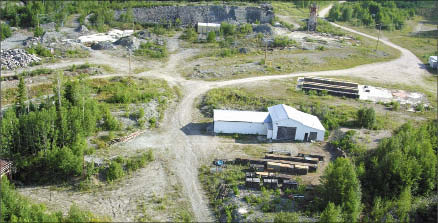Results from infill and resource expansion drilling at Prodigy Gold‘s (PDG-V) Magino gold project near Wawa, Ont., sent the junior’s shares up 10% to close at 64¢ on Aug. 30.
The drilling focused on two parts of its 100%-owned Magino gold deposit – the southwest corner of the proposed open pit, and the central area.
Drill hole 11-105 in the southwest portion of the deposit intercepted 161 metres of 1.35 grams gold per tonne; hole 11-102 in the central area returned 36 metres of 2.64 grams gold per tonne; and hole 11-98 to the northeast of hole 11-102 cut 129 metres grading 1.01 grams gold.
Prodigy says these and previous drill results will expand the project’s gold resources and cut the strip ratio within the proposed open pit.
The results will be incorporated into an updated resource estimate in late September, followed by a revised preliminary economic assessment.
“The nearly completed infill drilling program, combined with additional metallurgical studies and the recently reported geotechnical data allowing for steeper pit walls, should significantly improve project economics,” Brian Maher, Prodigy’s chief executive, said in a statement.
The property includes the past-producing Magino underground gold mine, located 40 km northeast of Wawa and 14 km southeast of the town of Dubreuilville.
The Magino gold mine was in production from 1988 until 1992, during which time it produced 697,190 tonnes of ore at a recovered grade of 4.70 grams gold per tonne, yielding 105,543 oz. gold. All production was from underground operations using shrinkage and long-hole stoping.
Prodigy is evaluating Magino as an open-pit mining opportunity with potential for deeper, higher-grade gold production.
Prodigy updated its resource estimate for Magino in February, reporting indicated resources within a 51.6-million-tonne conceptual pit shell grading 1.16 grams gold for 1.92 million oz. contained gold.
Using the same cut-off grade of 0.35 gram gold per tonne, inferred resources are calculated at 18.3 million tonnes grading 1.04 grams gold for 587,100 oz. contained gold.
Prodigy released its initial preliminary economic assessment in April. The study shows that at a base case of US$1,000 per oz. gold, the operation would yield a pre-tax net present value of $351 million at a 5% discount rate, generating a 49% internal rate of return with a payback period of 1.8 years.
Pre-tax cash flow from operations over the proposed mine is estimated at $796 million, with net cash projected to be $520 million over the life of the mine.
Start-up capital costs are estimated at $242 million with an additional $34 million in sustaining capital.
The life-of-mine average strip ratio is estimated to be less than 2.8-for-1.
The PEA contemplates using a conventional carbon-in-leach processing facility operating at 15,000 tonnes per day.
Average annual production is estimated at 166,500 oz. gold a year over a nine-year operating life producing 1.5 million oz.
gold. Average life-of-mine cash operating costs, excluding sustaining capital, are pegged at US$496 per oz.
At presstime Prodigy traded at 53¢ per share within a 52-week range of 19¢-81¢.


Be the first to comment on "Magino holds promise for Prodigy Gold"